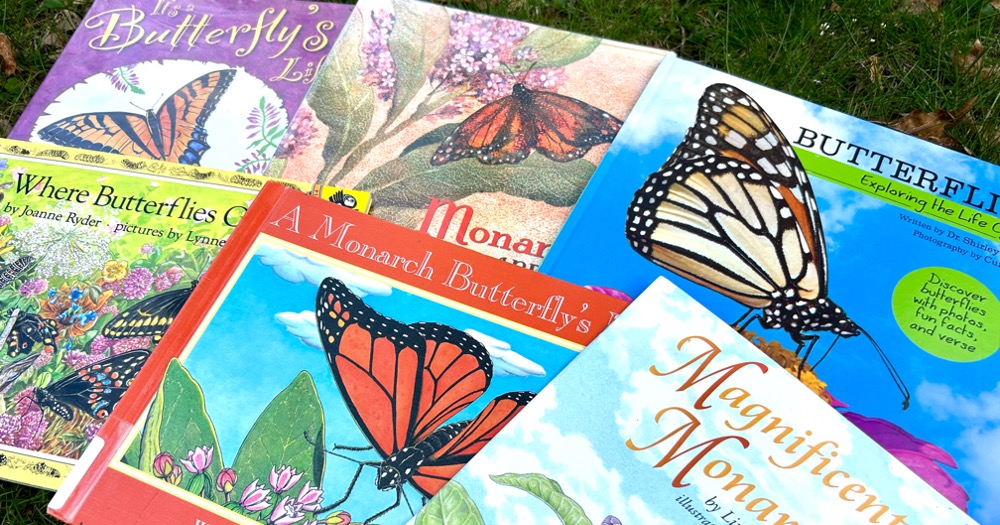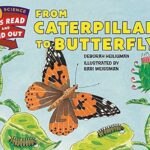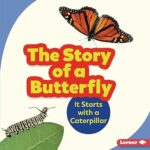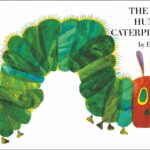Science
Frogs and Toads Together: Why do Amphibians Group Up?April 11, 2025


Butterflies are a hot topic for students and teaching about how butterflies grow can be a great way to tie their interests into the standards. If your district uses the Next Generation Science Standards (NGSS), 3rd graders are supposed to “develop models to describe that organisms have unique and diverse life cycles but all have in common birth, growth, reproduction, and death” (NGSS 3-LS1-1).
Get your students engaged with the idea of butterfly life cycles by starting with a picture book about how butterflies grow. Butterflies experience complete metamorphosis, aka four distinct life stages, and are a great first example of insect life cycles for any aged child.
The integration of picture books in your efforts to discover how butterflies grow can really help your students understand the ebb and flow of animal stages. Picture books have been shown to generate interest and motivation in students as well as provide context, encourage communication, and connect science information in real-world context, making them the perfect place to start your science unit (Mahzoon-Hagheghi, 2018, 41).
A Monarch Butterfly’s Life by John Himmelman
Reading age: Kindergarten – 3rd grade (5-8 years)
Himmelman begins this story in the summer when a monarch butterfly migrates north where she lays eggs on milkweed plants. A caterpillar hatches and feeds on milkweed leaves. After eating a lot, the caterpillar attaches herself to a fence and turns into a chrysalis and then emerges as an adult butterfly. In the fall, she makes her journey south to Mexico with millions of other monarch butterflies. In the spring she makes her way north again where she mates, lays eggs, and dies. A great story to show the Monarch butterfly’s life cycle but also the adaptation to migrate, a technique used to survive winter and continue the population.
Monarch and Milkweed by Helen Frost
Reading age: Preschool – 3rd grade (3-8 years)
Frost introduces the relationship between Monarch butterflies and their host plants, the Milkweeds, in this lovely and descriptive storyline. She begins with the journey of a female Monarch that migrates from Mexico back to its northern mating grounds in search of milkweed. When she arrives, she finds a mate, lays an egg, and the caterpillar hatches and eats the milkweed leaves. The Monarch butterfly pupates, changes, and emerges as an adult where it makes its way to Mexico for the winter.
During the story of the Monarch butterfly, the milkweed plant gets pollinated, creates a seedpod, the seedpod dries out, and the seeds ride the wind to a different location where a new milkweed plant sprouts. This is a great combination of how butterflies grow and flower life cycles, all wrapped up in one beautiful storyline.
Magnificent Monarchs by Linda Glaser
Reading age: Kindergarten – 3rd grade (5-8 years)
Glaser shares the story of a female Monarch caterpillar hatching from an egg on a milkweed plant. As she eats and grows, she molts her skin until she sheds for the last time, revealing a chrysalis underneath. After she emerges from her pupa stage, she migrates south for the fall along with other Monarch butterflies. In the spring, she migrates north again and lays eggs on milkweed plants, starting the cycle again.
A Butterfly’s Life Cycle by Mary R. Dunn
Reading age: Preschool – 3rd grade (4-8 years)
Dunn shares the life cycle of a Monarch butterfly in this nonfiction book. With the help of real pictures, readers discover how butterflies grow with close ups of each life stage. Not only does Dunn introduce and name each life stage, she also shares a kid-friendly explanation of migration and how Monarchs fly south for the winter and north for the summer. This is a simple but very effective nonfiction picture book to introduce the Monarch butterfly’s life cycle.
A Butterfly is Patient by Dianna Hutts Aston
Reading age: Kindergarten – 3rd grade (5-8 years)
Aston personifies different characteristics of the butterfly life cycle and adaptations throughout this lovely story. She also includes great examples and facts alongside these personifications in insets on each page. The nature journal illustrations by Sylvia Long include a variety of species as well as labeled diagrams to help the reader better understand how butterflies grow. Some of the characteristics Aston gives to butterflies include being helpful, protective, creative, spectacular, and of course, patient.
Where Butterflies Grow by Joanne Ryder
Reading age: Kindergarten – 3rd grade (5-8 years)
For a list of picture books about how butterflies grow, this is a perfect book to include. Ryder wrote an interactive book that draws the reader into the life cycle of a Black Swallowtail. The wording encourages the reader to imagine themselves at each stage in the life cycle starting with a tiny egg and growing larger until they burst from their pupa. She describes the progression through the life cycle with verbs such as creeping, balancing, nibbling, and more. This is a great option to get your students moving and creating an experience to remember the stages of the life cycle.
Butterflies: Exploring the Life Cycle by Dr. Shirley Raines
Reading age: Kindergarten – 3rd grade (5-8 years)
Raines provides an opportunity to integrate science and literacy with this book specifically written with STEAM learning in mind. The beginning of the book provides an explanation of the benefits of science and art in helping students learn and extend their literacy skills, a great bit of information to consider. The book is written in parts with poems supplying an artistic take on the topic for the spread and then an inset with the scientific explanation. Both butterfly life cycles and adaptations are addressed in this book with photographs. The end of the book includes story stretcher ideas for science, language, science/language, music/movement, and art.
It’s a Butterfly’s Life by Irene Kelly
Reading age: 1st grade – 3rd grade (6-8 years)
Kelly shares a bounty of information about how butterflies grow and their special adaptations. She shares a breakdown of the Lepidoptera order, including similarities and differences between butterflies and moths, and she uses examples of a variety of butterfly species to illustrate her points. Butterfly needs, adaptations, and mating rituals help your students understand how butterflies grow in all aspects of their lives, not just in their life cycles.

From Caterpillar to Butterfly by Deborah Heiligman
My thoughts: this book is a Teacher’s Choice on Amazon, and I can see why it would be appealing at first glance. However, if you’ve read my article about raising butterflies kits, you could see where I’m going with these thoughts. The science behind this book is solid, but it’s insinuating a lot of things. First, it’s suggesting that it’s okay to take caterpillars from the wild to take care of inside; some states don’t allow this sort of “harvesting” or caretaking, especially species of special concern. It’s best to leave animals outside, and as teachers helping students understand how butterflies grow, we should encourage best practices.
Second, the book suggests that butterflies are caterpillars for 12-14 days and that they stay in their chrysalis for 7 days; although this may be true for Painted Lady butterflies, it’s not true for all butterflies. As an example, the second generation of Black Swallowtails each year overwinters as a chrysalis, meaning they’ll spend months waiting to change from pupa to adult. If we teach our students that it’s okay to take caterpillars out of the wild because they will change to an adult within a week, there could be some issues if they get the wrong kind of butterfly species at the wrong time of the year.
Third, not all caterpillars are made equal. Like I stated, some caterpillars have longer life cycles, including moth caterpillars. These little larvae can look very similar to butterfly caterpillars but take all winter to metamorphose into the adult. It’s also challenging to be able to tell the difference between a safe caterpillar and a potentially dangerous one. Some caterpillars have hollow hairs on their bodies that can get stuck in children’s skin, release toxins, and cause irritation.
These three points shouldn’t prevent you from reading this book in your class to teach how butterflies grow, but it is important to keep them in mind. We want to make sure as teachers that we are teaching ecologically responsible practices including minding what’s best for our local wild animals.

The Story of a Butterfly: It Starts with a Caterpillar by Shannon Zemlicka
This book is appealing for younger students especially with its simplistic storyline and use of photographs. However, my concern with this book is the way they present the chrysalis in their story about how butterflies grow. The books says “[a] shell forms”. Although this is true, it makes it sound like “the shell” forms overtop of the caterpillar instead of underneath the last caterpillar skin.
When a butterfly is ready to pupate, the chrysalis forms inside as a layer just below the last caterpillar skin. If you look at the pictures in the book, you can see that the caterpillar skin splits and sheds off, revealing the chrysalis. Again, this doesn’t prevent you from reading this book in your class, it’s just a point to be aware of so that you can help children avoid creating misconceptions. It’s a minor detail, but still important.

The Very Hungry Caterpillar by Eric Carle
When it comes to teaching how butterflies grow, The Very Hungry Caterpillar is a go-to, especially for early childhood teachers. I think this is a great book to teach students the days of the week and counting, but it is not accurate for teaching the butterfly life cycle. Carle refers to the pupa stage at the end of the story as a cocoon, when most butterfly pupae are called chrysalises.
This could be a book that you use to help your students identify misinformation. After you’ve spent some time learning about the butterfly life cycle, let them know that you are going to read a book about the life cycle of a butterfly, but something isn’t quite right. They’re going to be detectives and they are going to try to listen for the mistake the author makes. This could be a good way to reinforce their newly acquired information. If you want more on my thoughts about this books, check out my article where I go into more details.
Hopefully after reading this list of books about how butterflies grow you’ve found a wonderful book (or two or three…) to read with your class during your life cycle unit. If you’re looking for engaging activities to accompany a butterfly life cycle book, check out my “Butterfly Life Cycle and Heredity Mini Unit for 3rd Grade”. It’s got 5 ELA activities including writing an informational text and using a dictionary to discover the definition of scientific words from the text, as well as 4 science activities including a data collection opportunity and engineering. Enjoy your life cycle studies, it’s sure to be a time of growth for your students!
Bibliography
Mahzoon-Hagheghi, M.; Yebra, R.; Johnson, R. (2018). Fostering a Greater Understanding of Science in the Classroom Through Children’s Literature. Texas Journal of Literacy Education, 6(1), 41-50. https://files.eric.ed.gov/fulltext/EJ1183979.pdf
Have amazing books about how butterflies grow that weren’t listed? Include your favorites in the comments!
Check out this podcast episode for unique ways to teach with books!
Looking for more articles about books? Check out these other titles:
“Teaching With Books: How to Integrate Science and Literacy for Elementary Classrooms”
“18 Kids Earth Day Books to Inspire Elementary Students this Year”
“11 Fantastic Animal Life Cycles Books By John Himmelman”
“A Free Fall Picture Books List For Teachers With 16 Recommendations”
“16 Wonderful Children’s Books About Winter For Elementary Teachers”
“A Fantastic Spring Picture Book List For Elementary Teachers With 20 Titles”
0